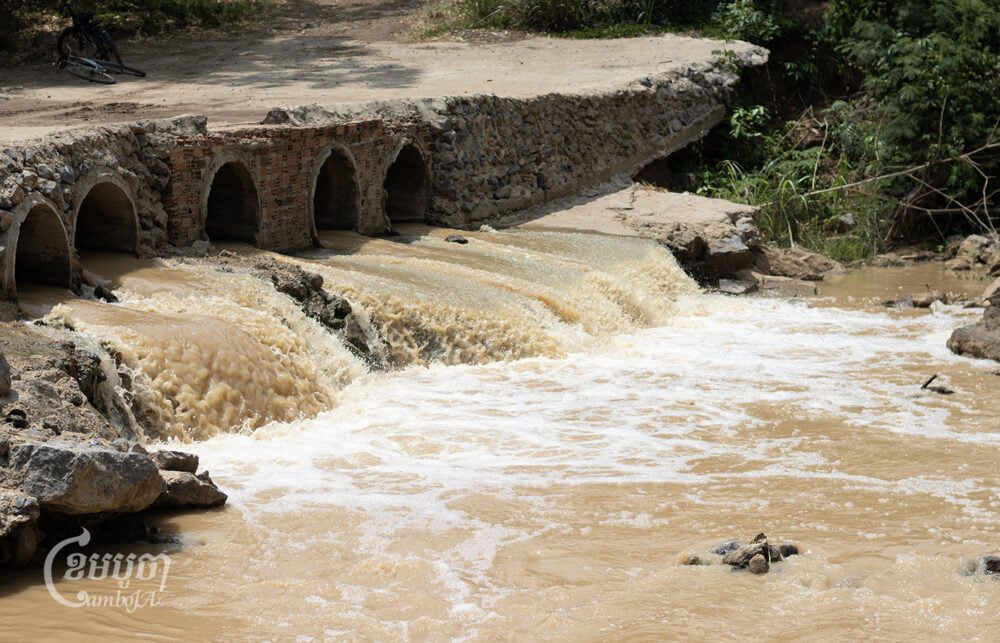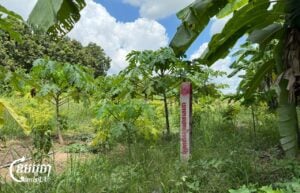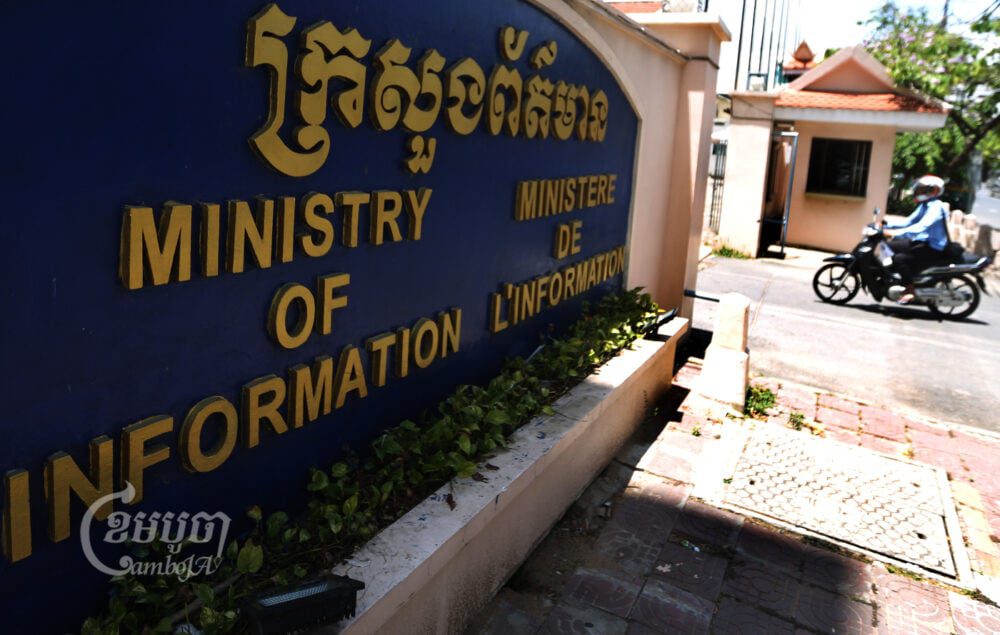Battambang provincial authorities have issued a warning letter to a Chinese owner of a mango processing factory that allegedly discharged sewage into O’ Treng stream in Svay Sar Village of Treng commune in Rattanak Mondul district.
The authorities intervention came on the heels of the residents posting of a video on social media on May 3, 2024, showing sewage water being released into the stream, and which likely caused many fish to die.
Resident Sorn Srey Neang, 33, said she did not know that the factory had released sewage into the stream until she was told by other villagers who saw dead fish floating.
It was her first time encountering this problem. She used the stream water to irrigate her crops and feed the cows. For daily consumption, her family takes water from the well. But she is worried that her young children might develop skin problems as they swim in the stream.
“[I] am also scared of the black ink [water] and dead fish. I saw that they scooped up half a bag of dead fish. I didn’t dare catch the fish because I was afraid that it might be poisonous,” said Sreyneang.
Another villager, 41-year-old Nam Sinath, said she and other villagers depend on the stream behind their house for daily use because there was not enough water in the dry season.
Ever since the Chinese company dumped wastewater from the mango processing factory into the stream, she too dared not use the water, instead buying a tank of water for 30,000 riel which can last for about three days.
Sinath said the stream was black, dirty and smelled bad with dead fish floating. She said the wastewater flowing into the stream may have contained “something toxic” that killed the fish.
“The black water stank like toilet water but they [the company] have stopped [or] postponed the release of wastewater into the stream for now. Although I live about 200 meters away, I could still smell it,” she added.
Water from the stream is used for daily consumption and irrigation but Sinath and the villagers have stopped using it since the stream became polluted, and resorted to buying water tanks.
“No one swims in the stream anymore. I’m still scared because the water still stinks, and it might be toxic and cause itchiness,” Sinath said.
She urged the authorities to strengthen enforcement and ensure strict controls on factories located near people’s homes to avoid problems affecting the lives of people in the area.
“If any company does this again, the authorities [must] come down and check to [not] let it flow into the stream. We don’t have water to use, so we buy water and it is very expensive during the dry season,” Sinath said.
Srey Pov, 41, shared similar views, noting that the discharge of wastewater from the factory was not happening for the first time. It has happened often as there are many mango and cassava factories in the area.
“This is not the first time the release of sewage has happened. Villagers are very active [in highlighting the issue] as it flows during the dry season when people run out of water. Everyone is dependent on the stream,” she said.
Pov believed that the water flowing from the mango processing plant might contain impurities that affected the skin because she had used the water from the stream and ended up with a rash and itchy skin.
“The mango processing factory uses ‘stones’ [calcium carbide] to ripen the mangoes,” she said, adding that the itchiness could also be due to the water used to wash the resin off the mangoes.
“I didn’t know why it happened. My neighbors experienced even more severe itchiness than me. When I came to my farm, I realized that this was probably due to the stream water,” Pov said.
She also pointed out that the mango processing factory has a waste disposal system but was not sure why it discharged the sewage into the stream.
She urged the relevant authorities to inspect the factories to ensure that factory owners comply with the technical standards to protect the people’s welfare.
Meanwhile, the Rattanak Mondul district administration confirmed via social media that the wastewater which caused the fish in the river to die was from a mango processing factory belonging to Cambodian Gome Farm Food Co Ltd in the village.
The authorities said the company allegedly released dirty water into O’ Treng and flowed into Stung Sangke, more than 10 km above the multi-purpose dam (road to Pailin province).
According to Svay Sar Village chief Vorn Choeun, about 200 families lived there, most of whom go to Thailand for work. During the dry season, they depend on the lakes and streams near the village for daily use as there are not enough wells.
Choeun told CamboJA News that following the villagers’ social media alert on the discharge of the sewage, the authorities inspected the site and shut down the sewage pipe. The factory owner was also issued a warning and made to sign an agreement to abide by the terms.
The current rainy weather has helped to improve the condition of the stream and there is no bad smell, he said, adding that the discharge might be due to the factory’s “negligence”, and that several recommendations were made by the authorities.
“It [the discharge] may have been intentional or unintentional because the factory relies on water storage tanks which may not be enough. When I walked near [the stream], it smelled.”
Kot Boran, director of Battambang Department of Environment, said the problem of sewage being discharged into O’ Treng has been resolved with the factory owner. Samples of the discharge have been taken for testing to determine any toxic substances. The results will be announced later.
However, he confirmed that the wastewater flowing into the stream was “not toxic water that could harm the people and biodiversity”. The authorities will continue to monitor the factory which is constructing a few more buildings to ensure it follows the technical standards.
“The team has inspected the drainage and got [the company] to sign [a warning] agreement. We have also made some recommendations to the owner,” Boran said. “We see that the dirty water will not seriously affect people and biodiversity, it is just normal mango washing water, not chemicals.”
The company could not be reached for comment.
In Kongchit, Licadho coordinating officer in Banteay Meanchey province, said the officers need to conduct strict inspection on the factory so that they follow technical standards and avoid making the same mistakes.
“The factory should have a separate solid waste storage tank and avoid discharging [wastewater] into streams that can flow into the Sangke River, and cause various diseases, because we know that many people use the Sangke water,” said Kongchit.
Private companies setting up businesses for personal gain should not cause difficulties to people, he stressed. Relevant ministries and departments should also check whether the company has done an environmental and social impact assessment. If there was none, it should be done immediately, he said.
In 2023, a similar problem occurred when a pharmaceutical company spilled chemicals into the Sangke River, polluting the water used by the community and killing many fish.











